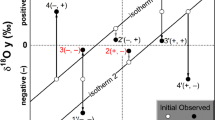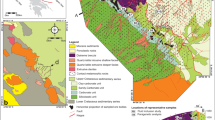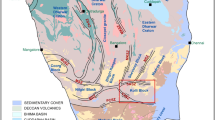Abstract
Thermochemical calculations and laboratory phase equilibration experiments on lavas of the 131 day 1983 Mt. Etna flank eruption of 0.1 km3 were undertaken to investigate possible systematic variations in inferred melt-phenocryst equilibration conditions as a function of time. The 1983 Mt. Etna lavas are multiply saturated; plagioclase, clinopyroxene and olivine, the dominant phenocrysts, occur in the ratio 1:1/2:1/4. Melts (glasses) plot close to the plagioclase saturated olivine-clinopyroxene low pressure cotectic on a Walker-O'Hara diopside-forsterite-silica diagram suggesting equilibration of melt and phenocrysts in a high level magma reservoir. Total pressures, temperatures and dissolved H2O concentrations were calculated using the isoactivity method of Carmichael and coworkers based on about 300 elelctron microprobe analyses of coexisting olivine, clinopyroxene and plagioclase phenocrysts, microphenocrysts and groundmass microlites for samples collected 6, 46 and 125 days after the start of the eruption. Total pressures (P t), temperatures and H2O contents based on representative olivine-clinopyroxene pairs are 140 MPa, 1105°C, 2.4 wt% H2O; 255 MPA, 1112°C, 1.0 wt% H2O and 85 MPa, 1096°C, 1.8 wt% H2O respectively for the early (283), middle (I83) and late (L83) samples. Corresponding equilibration depths are in the range 3 to 10 kilometers. Plagioclase feldspar phenocrysts, while showing more evidence of disequilibrium, provide compatible estimates of P t and T when analysis is restricted to the low anorthite mode of the plagioclase frequency-composition histograms: 133 MPa and 1115°C; 260 MPa and 1117°C and 103 MPa and 1104°C, repectively for 283, I83 and L83. The pre-eruptive (i.e., in situ) temperature-pressure gradient calculated from olivine-clinopyroxene equilibria is 10.6 K/kbar. This compares well with independent estimates of the temperature-pressure derivative of the (pseudo) invariant point composition (10 to 12 K/kbar) in both model (e.g., diopside-forsterite-anorthite, Presnall et al. 1978) and natural (e.g., Walker et al. 1979; Grove et al. 1982) systems. Apparently, magma within the Etna reservoir was in a quasiequilibrium state buffered by its multiply-saturated character immediately preceding eruption. The temporal variation of computed P t, T and H2O concentrations for melt-phenocryst equilibrium agrees well with predictions based on simulations of the withdrawal of magma from a body zoned with respect to dissolved H2O provided the temporal record of magma discharge is taken into account. Discharge varied by a factor of about 100 during the sample collection interval. The intermediate P t but high H2O content inferred for sample 283 reflects the withdrawal of H2O enriched magma during an early phase of high average discharge of about (3∼50 m3/s) before evaculation isochrons became quasistationary. The high P t and relatively dry I83 magma reflects the deepening of the evacuation isochrons after 50 days of intermediate discharge with the development of quasi-stationary isochrons in time and space. Sample L83 from day 125 near the end of the eruption reflects the “shoaling” of evacuation isochrons (hence low P t and relatively high H2O content) associated with the observed low (0.5 m3/s) discharge. Our results show that thermochemical modeling efforts provide important opportunities for testing the predictions of magma with-drawal simulations.
Similar content being viewed by others
References
Armenti P, Barberi F, Innocenti F, Pompilo M, Romano R, Villari L (1984) Composition variation in the 1983 and other recent Etnean lavas: insights on the shallow feeding system. Bull Volcanol 47:2
Barberi F, Hill D, Innocenti F, Luongo G, Treuil M (1984b) The 1982–1984 bradyscismic crisis at Phlegracan fields (Italy). Bull Volcanol 47:173–411
Barberi F, Coronado G, Innocenti F, Luongo G (1984b) Phlegraean fields 1982–1984: brief chronicle of volcano emergency in a densely populated area. Bull Volcanol 47:176–185
Cameron M, Papike J (1980) Crystal chemistry of silicate pyroxenes. Mineral Soc Am 17
Carmichael ISE, Turner FJ, Verhoogen J (1974) Igneous petrology. McGraw Hill, New York
Carmichael ISE, Nicholls J, Spera FJ, Wood BJ, Nelson SA (1977) High temperature properties of silicate liquids: applications to the equilibration and ascent of basic magma. Phil Trans R Soc Lond A 286:373–431
Condomines M, Tanguy JC (1976) Age de l'Etna déterminé par la méthode du déséquilibre radioactif 230Th/238. U Cr Acad Sci 282:1661–1664
Cristofolini R, Romano R (1982) Petrologic features of the Etnean Volcanic Rocks. Mem Soc Geol It 23:99–115
Cristofolini R, Menzies MA, Beccaluva L, Tindle A (1987) Petrological notes on the 1983 lavas at Mt Etna, Sicily with reference to their REE and Sr−Nd isotope composition. Bull Volcanol 49:599–607
Dolfi D, Trigila R (1983) Clinopyroxene solid solutions and water in magmas: results in the system phonolitic tephrite-H2O. Mineral Mag 47:347–51
Frazzetta G, Romano R (1984) The 1983 Etna eruption: event chronology and morphological evolution of the lava flow. Bull Volcanol 47–2:2
Frazzetta G, Romano R (1987) The 1983 Etna eruption: event chronology and morphological evolution of the lava flows. In: Guest JE, Kilburn CRJ, Pinkerston H, Duncan AM (eds) the evolution of lava flows fields: observations of the 1981 and 1983 eruptions of Mt Etna, Sicily. Bull Volcanol 49:527–540
Ghiorso MS (1987) Modelling magmatic systems: thermodynamic relations. In: Carmichael ISE, Eugster HP (eds) Thermodynamic modeling of geological materials, fluid and melts. Mineral Soc Am, Michigan
Ghiorso MS, Carmichael ISE (1980) A regular solution model for metaluminous silicate liquids: applications to geothermometry immiscibility and the source of regions of basic magma. Contrib Mineral Petrol 71:323–342
Ghiorso MS, Carmichael ISE (1985) Chemical mass transfer in magmatic processes II. Applications in equilibrium crystallization fractional and assimilation. Contrib Mineral Petrol 90:121–141
Grove TL, Gerlach DC, Sando TW (1982) Origin of calc-alkaline series lavas at Medicine Lake volcano fractionation, assimilation and mixing. Contrib Mineral Petrol 80:160–182
Guest JE, Kilburn CRJ, Pinkerton H, Duncan AM (1987) The evolution of lava flow fields: observations of the 1981 and 1983 eruptions of Mt Etna, Sicily. Bull Volcanol 49:527–540
Hamilton DL, Wayne-Burnham C, Osborn EF (1964) The solubility of water and effects of oxygen, fugacity and water content on crystallization in maffic magmas. J Petrol 5–1:21–39
Kieffer G (1973) Une éruption à caractères katmaiéns à l'origine de coulées ponceuses et de coulées de ponces, responsable de la formation de la caldeira du cratère elliptique de l'Etna (Sicile). C R Acad Sc Paris 277:2321–2324
Kieffer G (1974) Existence probable d'une Caldeira d'une quinzaine de kilomètre de diamètre dans la structure de l'Etna (Sicile). Geol Med 1:133–138
Kieffer G, Nicoloso A, Tanguy JC (1975) Sur réveil du cratére Nord-Est de l'Etna (29.9.74) et le mécanisme de l'activite volcanique persistente Cr Acad Sc Paris 280-D:701–704
Le Maitre RW (1976) The chemical variability of some common igneous rocks. J Petrol 17:589–637
Nicholls J, Carmichael ISE (1972) The equilibration temp and pressure of various lava types with spinal-and garnet periodotite. Am Mineral 57:941–959
O'Hara MJ (1968a) The bearing of phase equilibria studies in synthetic and natural systems on the origin and evolution of basic and ultrabasic rocks. Earth Sci Rev 4:69–133
Peterson D (1988) Volcanic hazards and public response. J Geophys Res 93 (B5)4161–4170
Presnall DC, Dixon SA, Dixon JR, O'Donnell TH, Brenner NL, Schrock RL (1978) Liquidus phase relations on the joint diopside-forsterite-anorthite from 1 atm to 20 kbar: Their bearing on the generation of crystallization of basaltic Magma. Contrib Mineral Petrol 66:203–220
Rittman A (1963) Vulkanismus und Tektonik des Aetna. Geol Rundsch 53(2): 788–800
Romano R, Sturiale C (1982) The historical eruptions of Mt Etna (volcanological data) In: R Romano (ed) Mt Etna Volcano, a review of the recent earth sciences studies. Mem Soc Geol Hal 23: 75–97
Sato M, Moore JG (1973) Oxygen and Sulfur fugacies of magmatic gases directly measured in active vents of Mt Etna. Phil Trans R Soc Lond 274:137–146
Scott SC (1983) Variations in lava composition during the March 1981 Eruption of Mt Etna and the implications of a compositional comparison with earlier historic eruptions. Bull Volcanol 46–4
Spera FJ (1984a) Some numerical experiments on the withdrawal of magma from crustal reservoirs. J Geophys Res 89:8222–8236
Spera FJ (1984 b) Carbon dioxide in petrogenesis III: role of volatiles in the ascent of alkaline magma with special reference to xenolith-bearing matic lavas. Contrib Mineral Petrol 88:217–232
Spera FJ, Yuen DA, Greer JC, Sewell G (1986) Dynamics of magma withdrawal from stratified magma chamers. Geology 14:723–726
Tanguy JC (1973 a) Une coulée de trachyte dans l'Etna récent. Cr Ac Sc Paris 277D:2605–2608
Tanguy JC (1973 b) The 1971 eruption petrography of the lavas. Phil Trans R Soc Lond A274:55–62
Tanguy JC, Kieffer G (1976) The 1974 eruption of Mt Etna. Bull Volcanol 40:1–14
Tanguy JC, Kieffer G (1977) The 1974 eruption of Mt Etna. Bull Volcanol 40:238–252
Walker D, Shibata T, DeLong SE (1979) Abyssal tholeiites from the oceanographer Fracture Zone II Phase equilibria and mixing. Contrib Mineral Petrol 70:111–125
Wood BJ, Fraser DG (1976) Elementary thermodynamics for geologist, Oxford Press, 301 p
Author information
Authors and Affiliations
Rights and permissions
About this article
Cite this article
Trigila, R., Spera, F.J. & Aurisicchio, C. The 1983 Mount Etna eruption: thermochemical and dynamical inferences. Contr. Mineral. and Petrol. 104, 594–608 (1990). https://doi.org/10.1007/BF00306667
Received:
Accepted:
Issue Date:
DOI: https://doi.org/10.1007/BF00306667




